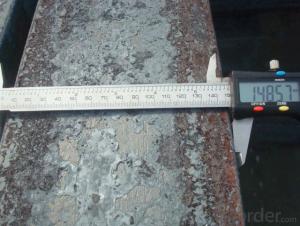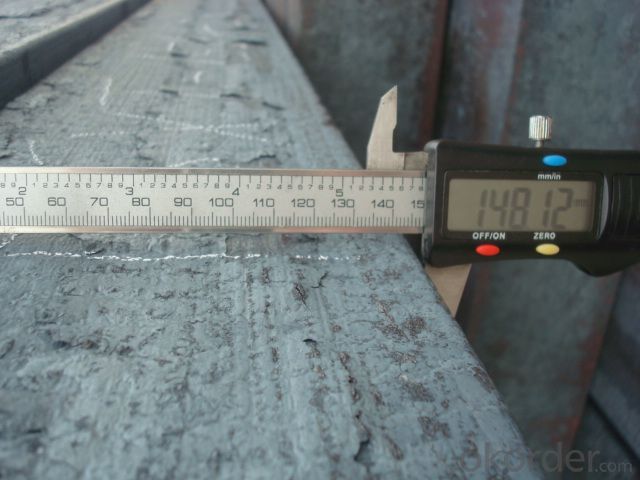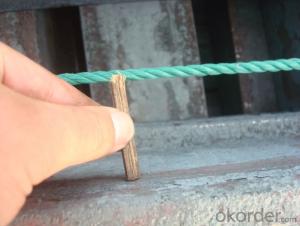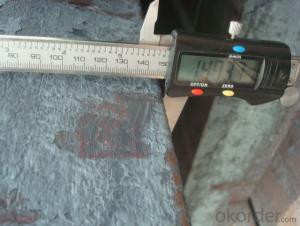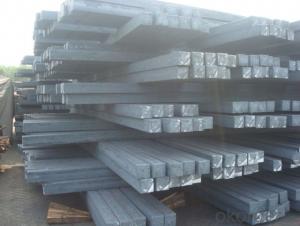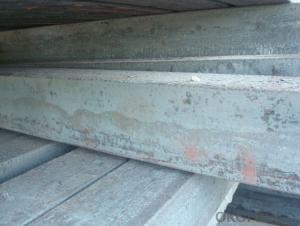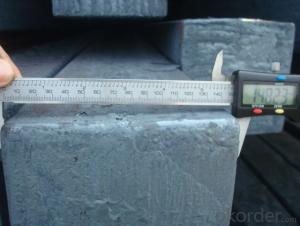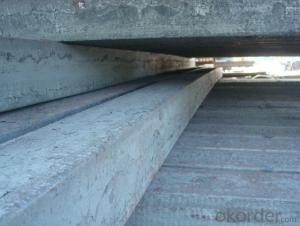Steel Billet Manufactured by Blast Furnace without Boron
- Loading Port:
- Tianjin
- Payment Terms:
- TT OR LC
- Min Order Qty:
- 1000 m.t.
- Supply Capability:
- 100000 m.t./month
OKorder Service Pledge
OKorder Financial Service
You Might Also Like
Steel Billet Manufactured by Blast Furnace without Boron
1.Structure of Steel Billet Manufactured by Blast Furnace without Boron
Steel Billet Manufactured by Blast Furnace without Boron is the raw material of all kinds of steel mill. Billet section of square, round, flat, rectangular and abnormity, etc Several, mainly related to shape of rolled products. Simple rolled section steel, choose cross section of square billet or rectangular billet. rolling The sector products such as flat steel, Angle steel, select the rectangular billet or slab. Had better profiled billet when production beams, channels, and in rolling process Lines and improve the yield. The raw material of round billet is the production of seamless tube.
2.Main Features of Steel Billet Manufactured by Blast Furnace without Boron.
Steel Billet Manufactured by Blast Furnace without Boron section size should meet the requirements of rolling deformation and finished product quality, but also roll strength and biting condition of restrictions. General steel Billet section height H. And the roll diameter D The ratio of the ( namely H/D) Should be less than or equal to zero 0.5 . Length of steel billet by finishing temperature, Rolling time and the length of the product Or times ruler. When heated too long accident prone to bump the furnace wall of steel, too short, furnace bottom utilization rate is not high, influence the heating furnace production. For the production Choose a variety of steel and steel billet, should consider the affinities of billet, as far as possible in order to improve the productivity of the roughing mill, simplify the stock management of workshop.
3. Steel Billet Manufactured by Blast Furnace without Boron Images
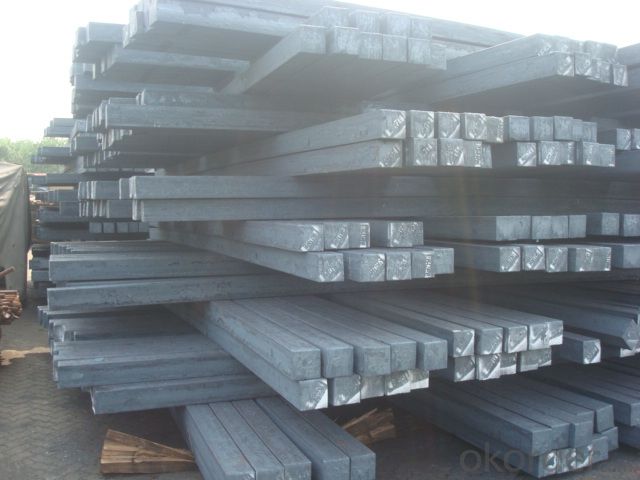
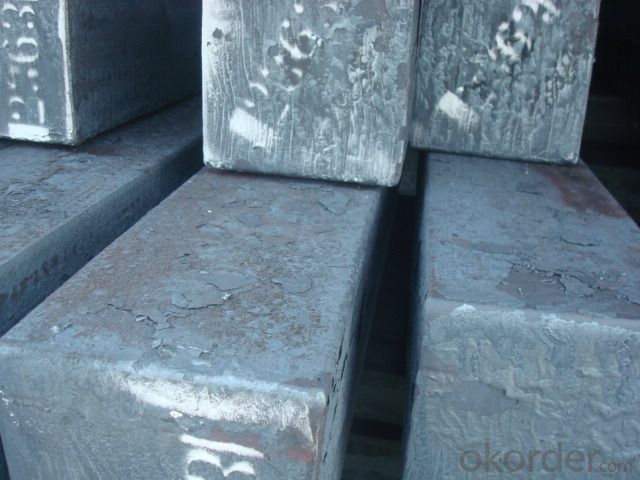
4. Steel Billet Manufactured by Blast Furnace without Boron Specification
Steel Billet Manufactured by Blast Furnace without Boron rolled steel, after processing can be used for mechanical parts, forging parts, processing all kinds of steel, steel Q345B channel steel, wire rod is the role of the billet. Steel billet is used in the production of semi-finished products, generally cannot be used directly for the society. Steel billets and steel are strictly divided into standard, cannot decide to whether the business enterprise of the final product, and according to unified standards to perform the whole society. Typically, billet and the steel is relatively easy to distinguish, but for some steel billet, and have the same specification and same steel purposes (such as rolling tube billet), whether can be used for other industries, whether through steel processing process, whether through a finished product rolling mill processing to distinguish
The classification of the Bloom Mainly from the shape is divided into two kinds: Slab: cross section width and height of the ratio of the larger, mainly used for rolling plate. Bloom: equal cross section width and height, or a huge difference, mainly used for rolling steel, wire rod.
Bloom material standard The thickness range: 150-240 - mm + / - 5 mm The width of the range: 880-1530 - mm + / - 20 mm Length range: 3700-10000 - mm + / - 500 - mm Cross-sectional size: 64 * 64 ; 82 * 82 ; 98 * 98 ; 124 * 124 ; 120 * 150 ; 152 * 164 ; 152 * 170 mm Length: 9000 mm The section of tolerance: Bloom: 1.0 + / - 2.0-1.0 + / - 1.0 mm The slab width: + / - 2.0 MM ; Thickness: + / - 3.0 MM
5.FAQ of Steel Billet Manufactured by Blast Furnace without Boron
We have organized several common questions for our clients,may help you sincerely:
①How about your company?
A world class manufacturer & supplier of castings forging in carbon steel and alloy steel,is one of the large-scale professional investment casting production bases in China,consisting of both casting foundry forging and machining factory. Annually more than 8000 tons Precision casting and forging parts are exported to markets in Europe,America and Japan. OEM casting and forging service available according to customer’s requirements.
②How to guarantee the quality of the products?
We have established the international advanced quality management system,every link from raw material to final product we have strict quality test;We resolutely put an end to unqualified products flowing into the market. At the same time, we will provide necessary follow-up service assurance.
③How is the packaging and delivery?
Exporting Package with the steel material cover and the delivery term is based on the project.
- Q: What are the potential applications of steel billets in the oil and gas industry?
- Steel billets have various potential applications in the oil and gas industry. They can be used for manufacturing pipes, tubes, and casings, which are essential for drilling and extraction operations. Steel billets are also used to produce valves, fittings, and other components that are necessary for the transportation and storage of oil and gas. Additionally, steel billets can be utilized in the construction of offshore platforms and equipment, providing durability and strength in harsh marine environments.
- Q: How are steel billets distributed in the market?
- Various channels and processes are utilized to distribute steel billets in the market. These channels can be broadly classified into three main methods: direct sales, distribution networks, and online platforms. Direct sales refer to the direct selling of steel billets by manufacturers or steel mills to customers, such as construction companies, fabricators, or steel service centers. This method allows manufacturers to maintain better control over pricing, quality, and delivery schedules. It also enables them to establish direct relationships with customers and gain insight into their specific requirements. Distribution networks play a significant role in the distribution of steel billets. These networks consist of wholesalers, distributors, and stockists who purchase steel billets from manufacturers and sell them to end-users or smaller retailers. Distribution networks have extensive market coverage, enabling them to serve a wide geographical area. They provide convenience to customers by maintaining an inventory of steel billets, ensuring timely availability, and reducing lead times. In recent years, online platforms have become a popular means of distributing steel billets. These platforms connect buyers and sellers of steel billets, facilitating efficient and convenient business transactions. Manufacturers can reach a global customer base through online platforms, while buyers have access to a wide range of suppliers and can compare prices and specifications. Online platforms also promote transparency and reduce the reliance on intermediaries, resulting in cost savings. Regardless of the distribution method, the transportation and storage logistics of steel billets are crucial. Steel billets are typically transported in bulk using various modes of transportation, such as trucks, trains, or ships. To ensure the quality and integrity of the billets, proper storage facilities equipped with cranes and heavy-duty machinery, such as warehouses or yards, are necessary. Overall, the distribution of steel billets involves a complex network of manufacturers, distributors, and online platforms working together to meet the diverse needs of customers. This ensures a consistent supply of steel billets in the market, supporting industries such as construction, manufacturing, and infrastructure development.
- Q: Are steel billets subject to any heat treatment processes?
- Yes, steel billets can be subject to heat treatment processes. Heat treatment is a controlled process of heating and cooling metals to alter their physical and mechanical properties. Steel billets, which are semi-finished steel products with a square or rectangular cross-section, can undergo various heat treatment processes depending on the desired properties for the final product. One common heat treatment process for steel billets is annealing. Annealing involves heating the billets to a specific temperature and then slowly cooling them to relieve internal stresses and improve their ductility and toughness. This process is typically used to soften the steel and make it more workable for subsequent manufacturing processes. Another heat treatment process for steel billets is quenching and tempering. Quenching involves rapidly cooling the heated steel billets in a liquid medium, such as oil or water, to achieve high hardness and strength. This process results in a hard but brittle material. To reduce the brittleness, the quenched billets are then tempered by reheating them to a lower temperature and slowly cooling them. Tempering improves the toughness and ductility of the steel while maintaining a certain level of hardness. Other heat treatment processes that can be applied to steel billets include normalizing, which involves heating the steel above its critical temperature and then cooling it in still air to refine the grain structure, and stress relieving, which is done to reduce residual stresses in the billets after extensive machining or welding. Overall, heat treatment processes can significantly enhance the mechanical properties of steel billets, making them more suitable for various applications in industries such as automotive, construction, and manufacturing.
- Q: Are steel billets subject to any international standards?
- Steel billets must adhere to international standards, as set by the International Organization for Standardization (ISO). These standards govern the production, quality, and dimensions of steel billets, guaranteeing that they meet specific criteria and are suitable for use in various industries, including construction, manufacturing, and engineering. ISO standards like ISO 683-2 and ISO 16143-1 outline guidelines for the chemical composition, mechanical properties, and tolerances of steel billets. Moreover, international trade organizations such as the International Trade Commission (ITC) and the World Trade Organization (WTO) may also establish regulations and standards for the import and export of steel billets to ensure equitable trade practices and product safety. Consequently, to ensure uniformity, quality, and compliance across different countries and markets, steel billets are subject to international standards.
- Q: What are the different surface finishes available for stainless steel billets?
- Some of the different surface finishes available for stainless steel billets include mill finish, brushed finish, mirror finish, satin finish, and bead blasted finish.
- Q: What are the common surface defects in steel billets during cooling?
- There are several surface defects that can occur during the cooling process of steel billets. These defects can be caused by factors such as improper handling, inadequate cooling techniques, or impurities in the material. Some of the most common surface defects observed in steel billets during cooling are as follows: 1. Scale Formation: When the steel is exposed to air during the cooling process, a thin layer of oxides called scale forms on its surface. This can result in a rough and uneven surface, which diminishes the overall quality of the billet. 2. Cracks: Thermal stresses induced in the steel during cooling can lead to the formation of cracks. These cracks can be longitudinal, transverse, or even intergranular, and they compromise the structural integrity of the billet. 3. Lamination: Insufficient bonding during the cooling process can cause layers or sheets of steel to separate, resulting in lamination defects. This weakens the billet and reduces its overall strength. 4. Shrinkage Cavities: As the steel solidifies and contracts during cooling, voids or cavities called shrinkage cavities can form on the surface of the billet. These cavities weaken the steel and affect its mechanical properties. 5. Surface Roughness: Inadequate cooling techniques can cause uneven cooling and rapid solidification, ultimately leading to a rough and uneven surface texture on the billet. This defect affects the surface finish of the billet and subsequent processing. 6. Decarburization: Exposure to high temperatures and oxygen during the cooling process can cause the surface of the billet to lose carbon content, resulting in decarburization. This reduces the hardness and strength of the affected areas. To minimize these surface defects, it is crucial to implement proper cooling techniques, including controlled cooling rates, the use of protective coatings, and appropriate handling practices. Regular inspection and quality control measures are also essential to identify and rectify any defects during the cooling process, ensuring the production of high-quality steel billets.
- Q: How do steel billets contribute to the manufacturing of sports equipment?
- Steel billets contribute to the manufacturing of sports equipment by providing a strong and durable material for various components. These billets are often used to create the frames, shafts, and other structural parts of sports equipment such as golf clubs, tennis rackets, and bicycles. The high strength and resilience of steel make it ideal for handling the rigorous demands of sports activities, ensuring that the equipment can withstand impact, vibrations, and repetitive use. Additionally, steel billets can be easily shaped and molded into different forms, allowing manufacturers to create customized designs that enhance performance and optimize weight distribution.
- Q: What is the role of steel billets in the manufacturing of automotive suspension systems?
- Steel billets play a crucial role in the manufacturing of automotive suspension systems as they serve as the raw material for producing various components like springs, shock absorbers, and control arms. These billets are heated, shaped, and machined to create strong and durable suspension parts that can withstand the forces and vibrations encountered while driving. Overall, steel billets are essential in ensuring the structural integrity and performance of automotive suspension systems.
- Q: What industries use steel billets?
- Several industries use steel billets, including automotive, construction, manufacturing, and infrastructure. Steel billets are commonly used as raw material in the production of various metal products such as pipes, rods, bars, wires, and sheets. They are also utilized in the construction of bridges, buildings, and other structural components. The automotive industry uses steel billets for manufacturing parts like engine blocks, chassis, and suspension components. Additionally, steel billets find applications in the energy sector, machinery production, and shipbuilding.
- Q: What is billet?
- At present, the casting process has been basically eliminated.Mainly from the shape of two:Slab: the ratio of section width and height is larger, which is mainly used for rolling plate.Billet: cross section width, height equal, or difference is not big, mainly used for rolling steel, wire.
Send your message to us
Steel Billet Manufactured by Blast Furnace without Boron
- Loading Port:
- Tianjin
- Payment Terms:
- TT OR LC
- Min Order Qty:
- 1000 m.t.
- Supply Capability:
- 100000 m.t./month
OKorder Service Pledge
OKorder Financial Service
Similar products
Hot products
Hot Searches
Related keywords
